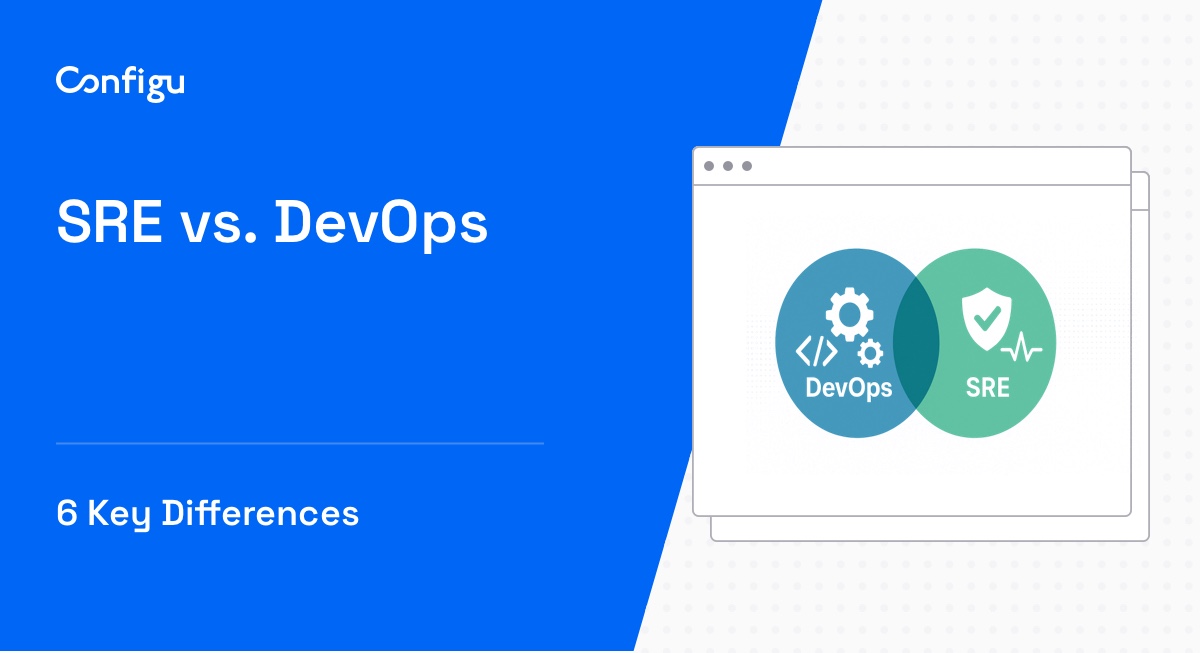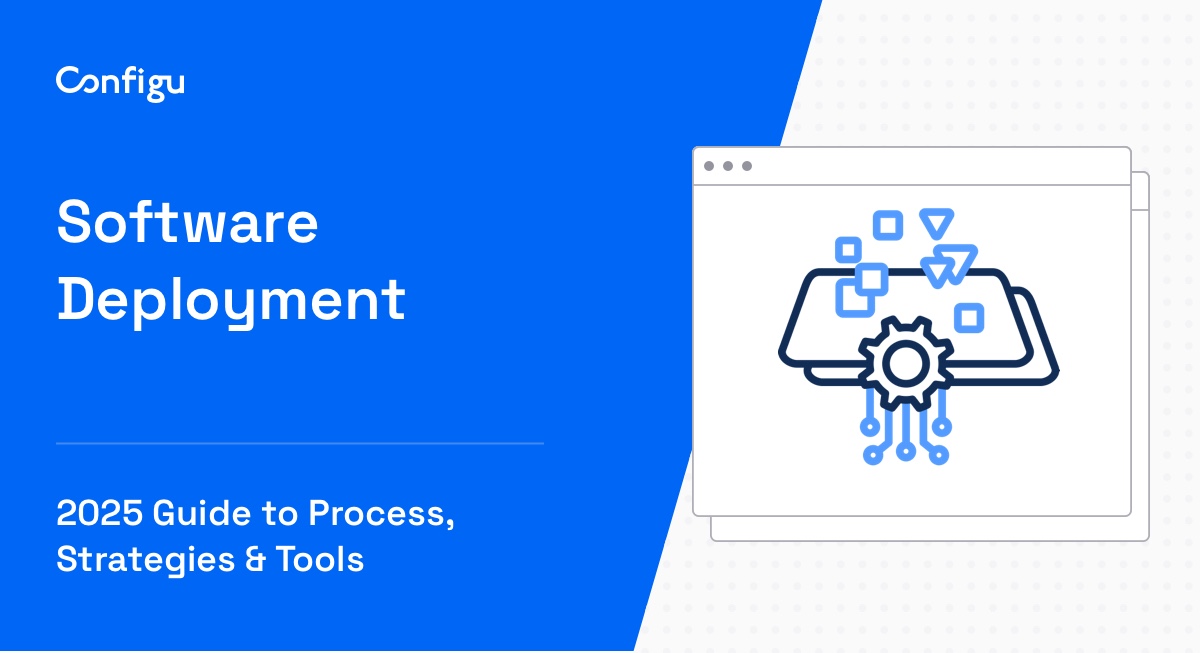What Is Configuration Management Software?
Configuration management software is a tool that helps automate the process of tracking and controlling changes in computing systems. It’s about maintaining the integrity and consistency of a system throughout its lifecycle. This software allows you to manage changes systematically so you can maintain system control and reduce malfunctions and downtime.
Configuration management has grown in importance in recent years. With the complexity and scale of modern IT environments and applications, managing configurations manually is no longer feasible. Configuration management solutions provide a centralized platform for managing changes across environments, with the ability to track configuration changes, manage changes, automate configurations, provide reporting, and more.
Whether you’re managing a data center, a cloud deployment, or a complex microservices application, configuration management software can make your work much easier.
In this article:
Types of Configuration Management
Let’s review the two main types of configuration management in the modern IT landscape: configuration management for infrastructure and applications.
Configuration Management for Infrastructure
Configuration management for infrastructure helps ensure that all hardware and software components are configured correctly and working together seamlessly. This involves tracking every component in your infrastructure, from servers and network devices to operating systems and the services they run.
Configuration management for infrastructure also involves managing changes to these components. This could be anything from installing a new server to updating a software application. Configuration management software helps ensure that these changes are carried out correctly and efficiently, minimizing the risk of errors and downtime.
This software also helps maintain system consistency across your infrastructure. It ensures that all similar components are configured the same way, reducing the risk of inconsistencies that could lead to problems down the line. This is especially important in large IT environments.
Configuration Management for Applications
The field of application deployment and management, a configuration management solution helps ensure that an application is configured correctly and working together seamlessly. This involves centrally managing configuration files, environment variables, and secrets, managing them across all application components, and tracking changes to these configurations.
Configuration management for applications also involves managing the relationship between applications and the infrastructure they run on. This requires making sure that applications are compatible with the underlying infrastructure and that changes to one do not adversely affect the other.
Additionally, configuration management helps maintain application consistency. It ensures that all applications are configured in the same way, reducing the risk of inconsistencies that could lead to problems. This is especially important in microservices applications that could have dozens of hundreds of individual services, each with one or more instances.
In the remainder of this article, we’ll focus on each of these types in more depth.
Configuration Management for Infrastructure
Why It’s Important
Configuration management has long been a core component in IT infrastructure management. Its key benefits include:
- Ensuring system consistency: Maintains a single source of truth about your infrastructure’s state, reducing the risk of inconsistencies and errors. Consistency is key in maintaining a reliable and efficient IT environment.
- Enables replication: With configuration management software, you can quickly and accurately replicate system settings across multiple servers or environments.
- Change management: By controlling and tracking all changes to your infrastructure, you can ensure that only approved and authorized changes are made. This helps prevent accidental or unauthorized changes that could lead to operational or security risks.
- Streamlining backup and recovery: By maintaining a complete record of your system’s state, you can quickly restore your system to a previous state if something goes wrong. This can significantly reduce downtime and keep your business running smoothly.
Core Features
Here are the main features of a modern configuration management system:
- Automated configuration tracking: Automatically tracks all changes to your systems, ensuring that you always have an up-to-date record of your system’s state.
- Change management: Change management involves managing all changes to your system, ensuring that changes are tested, approved, and authorized.
- Version control: Version control allows you to keep track of different versions of your system’s configuration, making it easy to roll back changes if necessary.
- Audit trails: Provide a complete record of all changes to your system, making it possible to track changes and identify potential issues.
- Reporting and analytics: Provide valuable insights into your system’s state and performance, helping you make informed decisions about your IT infrastructure, and helping meet compliance requirements.
Popular Solutions
There are several popular solutions when it comes to configuration management software. Each comes with its own set of features and benefits. We will be looking at five of these solutions:

Puppet
Puppet, one of the pioneers of modern configuration management, is designed to automate the administration tasks of your IT infrastructure. It offers a robust framework for enforcing consistency across your environments.

Source: Puppet
Puppet uses declarative language to describe system configuration, which means you specify what you want the system to look like, not how to get there. This abstracts away many of the complexities of system administration. With Puppet, you can manage configurations, deploy software, and orchestrate the overall state of your infrastructure.
Puppet also provides reporting and compliance features that offer insights into your infrastructure, helping you understand what has changed, why, and the impacts of those changes. This is important for auditing and compliance reporting.

Ansible
Ansible is an IT automation platform designed to make applications and systems easier to deploy. Unlike Puppet, Ansible uses a procedural language where instructions are given step-by-step. This makes Ansible an excellent choice if you need to build and manage complex workflows with full control over deployment processes. However, some elements of Ansible use declarative logic to handle configurations.

Source: Ansible
With Ansible, you can automate three types of tasks: configuration management, application deployment, and orchestration. Ansible uses YAML to write automation tasks, which makes it easy to understand and learn. Importantly, Ansible doesn’t require any special software or agents to be installed on the nodes it manages and has a very low system overhead.

Chef
Chef is another powerful automation platform that transforms infrastructure into code. Chef allows you to automate how you build, deploy, and manage your infrastructure. Like Ansible, Chef’s approach to configuration management is a mix of declarative and procedural styles.

Source: Chef
Chef uses a Ruby-based domain-specific language (DSL) for writing system configurations. This means that if you’re comfortable with Ruby, you’ll find it easy to use Chef.
Chef has a vibrant community that contributes hundreds of cookbooks (Chef’s term for scripts) that help automate everything from managing databases to setting up entire application stacks. This active community ensures that Chef stays up-to-date with the latest technology trends and best practices.

Salt Project
Finally, we have the Salt Project, a Python-based, open-source configuration management software and remote execution engine. Salt is known for its speed and scalability, making it a great choice for managing and automating large-scale deployments.

Source Salt
Salt uses a declarative language to describe the desired state of a system, much like Puppet. One of its unique features is its use of the ZeroMQ messaging library for transporting requests and responses between the master and its minions (Salt’s term for managed nodes). This contributes to Salt’s speed and ability to manage thousands of nodes simultaneously.
Configuration Management for Applications
Modern software applications have grown more complex, often using a microservices architecture with a large number of interconnected services, and spanning multiple environments such as development, testing, and production.
Each microservice in each environment might require unique configurations to function, which presents a significant management challenge. Configuration management tools help streamline the process and achieve control over configurations across the application lifecycle.
Configuration management tools reduce the need for error-prone manual management, and ensure that application components are consistent across various environments. This consistency is achieved through the use of environment variables, which are a core component of application-level configuration management.
We should note that the field of application-level configuration management is still new. Many developers and organizations still use rudimentary tools like dotenv libraries, and might not even have a secrets management solution in place to secure sensitive data. But the field is rapidly advancing, with software like Configu offering a full-featured solution for all aspects of application configuration management.
What Are Environment Variables?
Environment variables are values that can affect the way running processes behave on a computer. They exist in every operating system and in most programming frameworks, and are used by the operating system, the runtime environment, or the application, to gain information about the environment. They can be stored in configuration files, most commonly .env files, and can be managed by secret vaults or configuration management tools.
Environment variables can hold data that includes the location of all user profiles, where temporary files are stored, and various system settings. They are crucial in application development as they allow software to behave differently based on the current context or the environment they are running in.
Why Are Environment Variables Important?
Here are a few reasons environment variables are a critical part of modern applications:
- Separation of code and configuration: This is one of the software design principles of the “Twelve-Factor App”, which is the basis of the microservices architecture. By keeping code and configuration separate, you can update configurations without changing the code, thus streamlining deployment and maintenance. This separation also allows for more modular and maintainable code.
- Contextual behavior: Environment variables allow software to adapt its behavior according to the environment it’s running in, whether that’s development, testing, or production. This is essential for consistency and predictability across different stages of the software lifecycle.
- Portability: Storing configuration data in environment variables makes the software more portable. This means you can easily move it across different systems without having to change the code. All you’d need to do is set the appropriate environment variables on the new system.
- Parameterization: Environment variables allow for dynamic assignment of values. This is useful for situations where you need to adjust resource allocation, feature flagging, or toggle settings without redeploying the application.
- Scalability: In a microservices architecture, managing configurations for each service instance can be difficult. Environment variables provide a centralized way to manage these configurations, supporting the scalability of the system.
- Security: Sensitive data such as API keys and passwords should never be stored as part of your code. Storing them as environment variables, which are not checked into source control, reduces the risk of accidental exposure or unauthorized access. However, environment variables are stored in plaintext and are also vulnerable to compromise, making it important to manage them with configuration management tools.
Options for Managing Environment Variables
Here are a few common ways developers manage environment variables:
dotenv Libraries
dotenv libraries are a software library that allows you to load environment variables from a .env file into your software. They are available in all programming languages and are straightforward to use. You can store all your environment variables in one place, making it easier to manage and control them.
The downside of dotenv libraries is that they are not secure, because they store environment variables in plaintext. They also don’t provide tools for managing complex configuration across multiple services and environments.
System or Platform Environment Variables
System environment variables are a built-in feature in operating systems. They are values that can affect the processes of the computer system. These variables can be accessed and modified, offering a way to influence the behavior of various software systems on the computer.
Similarly, many cloud platforms and development tools provide their own system for managing environment variables. Many of them offer security features and secret management capabilities. This is one step up from managing environment variables in .env files, but the capabilities of platform configuration management might vary, and they are typically limited to the specific platform, meaning application configuration is not portable.
Configuration files
Configuration files are typically used to control the operation of a software, specifying initial settings for software, or to enable or disable specific features. These files are designed to be easily read and written by humans, making it easier for developers to manage and control the software’s operation.
The problem with static configuration files is that they are not centrally managed, typically not versioned, and represent “tribal knowledge” about specific application configurations. Changes to configuration files are difficult to manage and test, which can lead to serious operational and security issues.
Configuration as Code
Configuration as Code (CaC) is an approach that treats system configurations, including environment variables, as if they were code. This means you can version control your configurations, conduct peer reviews, and even run tests on them. In a microservices architecture, this is particularly valuable for maintaining a uniform environment across different services.
With CaC, you write a set of declarative statements that specify the desired configuration state, and the system adjusts to match this state automatically. This enables easier management, faster and more reliable deployments, better accountability for changes, and the ability to roll back to previous configurations.
Configuration Management Tools
Configuration management tools are software applications that manage and update application configurations. They help automate the management of environment variables and configuration files, making the process more efficient and less prone to error. Modern configuration management tools use a CaC approach, providing a framework for managing configurations as code across complex microservices architectures.
Key Features of Configuration Management Solutions
Configuration management software solutions come packed with features that make the management of software configurations more efficient. They provide a range of functions that can help you improve your software’s performance, reliability, and security.
Secrets Management
Secrets management involves the secure storage, access, and handling of sensitive data like API keys, passwords, and certificates. Configuration management tools encrypt sensitive information and only decrypt it at runtime. They also allow for dynamic secrets, meaning that they can generate and revoke keys based on schedules or rotation policies.
Permissions management
This feature allows you to control who has access to your software’s configurations, ensuring that only authorized personnel can make changes. You can grant or revoke access to specific users, making it easier to manage your software’s security.
Type Validation
Type validation ensures that the data entered into the software is of the correct type and otherwise valid (for example, has the appropriate length). This helps prevent errors that can occur when configuration is incorrectly set or changed, improving the software’s reliability and performance.
Test Framework
A test framework allows you to test your software’s configurations, ensuring that they are working as they should. This can help you automate configuration testing, run it together with your build and deployment process, and make it possible to catch and fix errors before they reach production environments.
Integration with Existing Systems and Workflows
You can incorporate configuration management into your existing DevOps processes and tools, making it easier to manage and control your applications. This can help make configuration management an inseparable part of the software delivery pipeline.
Reporting and Auditing
Configuration management solutions also offer reporting and auditing features. These functions provide detailed logs and analytics about who changed what, when, and why. This is important for tracking changes, debugging issues, and ensuring compliance with security policies or regulatory requirements.
Related content: Read our guide to misconfiguration
Tips From the Expert
-
Integrate immutability in infrastructure management
Adopt immutable infrastructure practices where any changes to configurations are made by replacing instances rather than modifying them. This ensures that you can always revert to a known good state and avoid configuration drift. -
Use service discovery for application configuration
For microservices, consider service discovery tools (like Consul) that dynamically manage configuration based on the current state of the environment. This allows services to automatically adjust to changes in infrastructure. -
Leverage blue-green deployments for configuration updates
When managing configurations in applications, use blue-green deployments to safely transition between configurations. This reduces downtime and allows you to test new configurations in production without affecting the current environment. -
Implement proactive monitoring of configuration changes
Implement automated monitoring tools (such as Prometheus or Datadog) to alert you to configuration changes that exceed predefined thresholds or fail validation tests. This early warning system can prevent configuration errors from causing downtime. -
Employ a GitOps approach for infrastructure configuration
Consider treating all infrastructure changes as code, version-controlled in Git repositories. This way, any changes to the infrastructure can be auditable, reversible, and tied to specific commits, reducing the risk of untracked manual changes.
Configu: The Leading Configuration Management Software for Your Applications
Configu is a configuration management platform comprised of two main components, the stand-alone Orchestrator, which is open source, and the Cloud, which is a SaaS solution:
Configu Orchestrator
As applications become more dynamic and distributed in microservices architectures, configurations are getting more fragmented. They are saved as raw text that is spread across multiple stores, databases, files, git repositories, and third-party tools (a typical company will have five to ten different stores).
The Configu Orchestrator, which is open-source software, is a powerful standalone tool designed to address this challenge by providing configuration orchestration along with Configuration-as-Code (CaC) approach.
Configu Cloud
Configu Cloud is the most innovative store purpose-built for configurations, including environment variables, secrets, and feature flags. It is built based on the Configu configuration-as-code (CaC) approach and can model configurations and wrap them with unique layers, providing collaboration capabilities, visibility into configuration workflows, and security and compliance standardization.
Unlike legacy tools, which treat configurations as unstructured data or key-value pairs, Configu is leading the way with a Configuration-as-Code approach. By modeling configurations, they are treated as first-class citizens in the developers’ code. This makes our solution more robust and reliable and also enables Configu to provide more capabilities, such as visualization, a testing framework, and security abilities.



